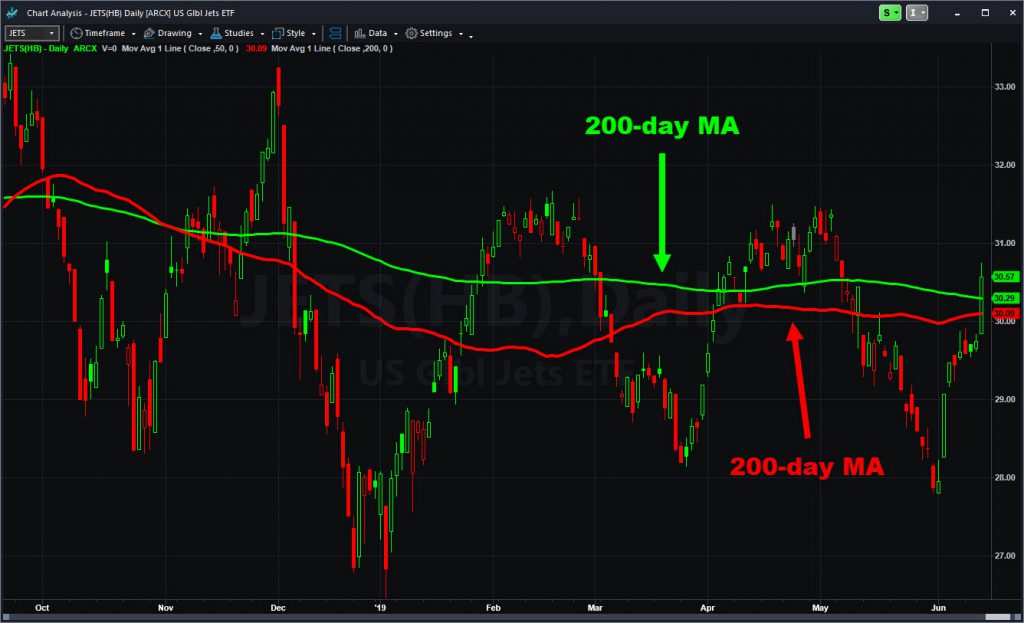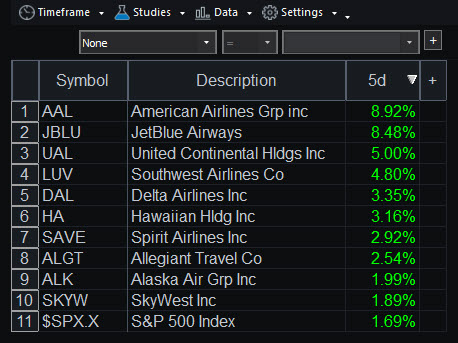Investors are jumping on board airlines, one of the few industries with pricing power in a low-inflation environment.
The U.S. Global Jets ETF (JETS) is up 10 percent since the beginning of June and is on pace for its best monthly gain in its four years of existence. It’s also leading virtually every other ETF in June — aside from SPDR Materials (XLB), featured last week.
JETS started to move on apparent value hunting. It then continued to run after J.P. Morgan noticed carriers like American Airlines (AAL) and Southwest Airlines (LUV) had raised fares. They were especially successful with the key business-traveler niche.

That followed a Goldman Sachs upgrade of United Continental (UAL) last week. The analyst argued that investors were too worried about the company’s shrinking Chinese exposure. UAL is the world’s biggest airline operator.
Finally Inflation Somewhere
Falling energy prices is another positive because jet fuel remains the industry’s largest input cost.
But let’s go back to pricing, which may be the most noteworthy part of the story. Most readers of Market Insights probably know inflation’s rising so slowly that the Federal Reserve is preparing to cut interest rates. That’s why XLB spiked last week.
The latest consumer price index from the Bureau of Labor Statistics showed clothing, energy and used vehicles got cheaper. However the same report specifically mentioned airline fares as one category on the rise.
Consider those two trends: rising prices for their services and falling input costs for fuel. Suddenly airlines seem to have a double-positive in terms of profit margins.
Members of the Global Jets ETF
The industry’s price action in the stock market has been so strong recently that the 10 largest holdings in JETS have outperformed the S&P 500 over the last week. Here’s a list:
- Delta Air Lines (DAL)
- United Continental (UAL)
- American Airlines (AAL)
- Southwest Airlines (LUV)
- JetBlue Airways (JBLU)
- SkyWest (SKYW)
- Allegiant Travel (ALGT)
- Alaska Air (ALK)
- Spirit Airlines (SAVE)
- Hawaiian (HA)
While JETS is heavily focused on carriers, it also has a small allocation to aerospace firms like General Dynamics (GD). A mix of international firms like Air Canada and Gol Linhas Aereas (GOL) are in in the portfolio as well.
Traders looking for exposure to airlines may want to consider the liquidity of different securities. One potential drawback of JETS is that it’s thinly traded, averaging less than 50,000 shares per day in the last month.

Individual holdings in the fund, on the other hand, are very active. DAL and AAL both average more than 5 million shares per session, while UAL typically has more than 3 million in turnover. The standalone companies also have more options volume, which tends to result in tighter bid/ask spreads. That means transaction costs are lower.
Regardless of how you approach it, the strength in JETS suggests sentiment is quickly turning more positive toward airline companies. Hopefully this post helps you understand some of the forces at work and key names to watch.
This post is part of our regular “ETF of the week” series. It focuses on exchange-traded funds with interesting news or price changes.
























